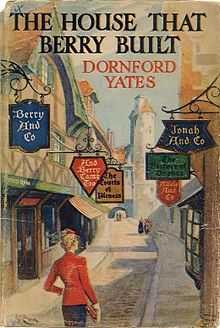The House That Berry Built
 First edition cover | |
| Author | Dornford Yates |
|---|---|
| Cover artist | J. F. Campbell[1] |
| Country | United Kingdom |
| Language | English |
| Series | The Berry Books |
| Genre | Semi-Autobiographical Comic novel |
| Publisher | Ward Lock & Co |
Publication date | 1945 |
| Media type | Print (Hardback) |
| Pages | 286 pp |
| Preceded by | And Berry Came Too |
| Followed by | The Berry Scene |
The House That Berry Built is a humorous semi-autobiographical novel by Dornford Yates published in 1945 by Ward Lock & Co of London. It is a fictional recreation of the construction of the author's house, Cockade, in the commune of Eaux-Bonnes, Pyrénées-Atlantiques, France.
Plot summary
This novel is from Yates' series of 'Berry Books', featuring Berry Pleydell, his relatives and close friends. It is the seventh in the series, all of which are period comedy-thrillers; however, where the earlier books in the series were made up of short stories, this is the second full-length novel, following Adele & Co. The House That Berry Built charts the Pleydell family's decision to sell White Ladies, their ancestral home in Hampshire, England, and move to Pau, in the South of France. Unable to afford their aristocratic lifestyle in England, and unhappy at social upheavals following the end of World War I, they take refuge in the South of France where they believe traditional values have not yet disappeared. Nostalgic for a vanished world of social events and elegant idleness, Berry and his friends spend their time driving their Rolls and picnicking on the slopes of the Valley of Ossau.
Wearied by the daily return journey from their residence at Pau, they decide to acquire some land on the green mountainside, halfway between the thermal spa of Lally and the village of Besse. Much of the novel is a thinly-veiled account of the building of 'Cockade', the writer's own residence between Eaux-Bonnes and Aas in 1938-9 (IKD).
In the novel, the house is called 'Gracedieu', and like its real-life equivalent it is constructed on a monumental built terrace anchored in the rock and is called "Le Château" by the people of the country.
Although it also contains a relatively minor sub-plot regarding the family's investigation of the murder of Sir Steuart Rowley, the novel's principal focus is upon an exceptionally precise description of the building of 'Gracedieu'. The cost of the work, the risks of the construction techniques employed, the whims of the mountain weather, the relations with the local contractor are all carefully detailed.
The House That Berry Built comes to an end with the completion of the house and the first signs of the Second World War. It becomes clear, soon after the family move into the house, that the impending war means they cannot remain there. Dornford Yates himself left France for southern Africa for the duration of the war.
Aftermath
In a later book of memoirs, As Berry And I Were Saying, Yates mentions that he had intended to write a sequel, but describes how Berry and his family had attempted a return to Gracedieu after 1945, but after "eight soul-searing months" found it impossible to stay on in France. They moved to Portugal, where they lived in hotel rooms and ultimately a small two bedroom cottage called Mimosa in Canas de Senhorim. (IKD)
Dornford Yates himself decided against resettling in the Pyrenees because of the changed attitudes and customs of post-war France. He moved permanently to Umtali, Southern Rhodesia, (now Mutare, Zimbabwe), where he built a small and economic colonial- style bungalow called "Sacradown", also on a hillside location. Interestingly enough, he did not use a house name on his writing paper as he did with Cockade, preferring the simple address of Oak Avenue, Umtali, Southern Rhodesia. (IKD)
Characters
- Bertram "Berry" Pleydell of White Ladies in Hampshire
- Daphne Pleydell, his wife and cousin
- Boy Pleydell, her brother
- Jonah Mansel, their cousin
- Jill, Duchess of Padua, Jonah's sister
- Sir Steuart Rowley, a judge of the Kings Bench
- Fergus Colin Shapely
- Albert Edward Tass
- Chief Inspector Falcon
Major themes
While not representing a crucial stage in the author's work, The House That Berry Built, through its abundance of anecdotal details, brings a personal perspective to the relationship the English maintained with France during the inter-war period. Notable are the irritation of the hero with the incompetence and the bureaucracy of the French administration and his mistrust in the face of the capacity of the French for destroying their most beautiful landscapes. Anglo-Saxon pragmatism is reflected in some astute remarks and especially admirable are the characters' respect for and sensitive appreciation of the Pyrenean landscape and nature in general. The novel reveals also the great ease of movement of the English at the beginning of the 20th century. The comings and goings between London and Pau, where there was a large British community, are numerous in this novel.
References
- Dornford Yates - A Biography; A.J.Smithers; Hodder & Stoughton 1982